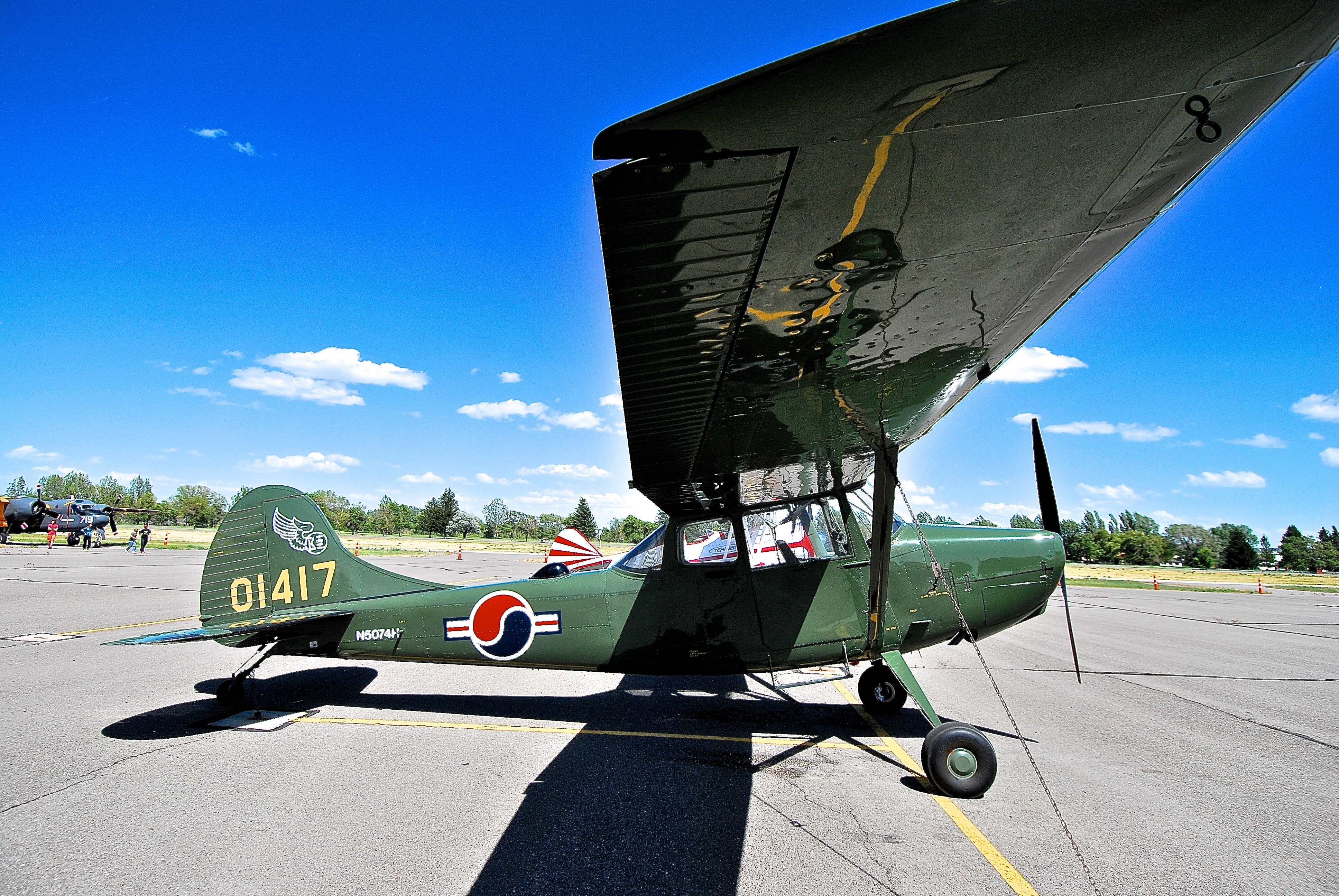I had just finished working with Tom, one of my T-6 students, after a great day of flying the Texan. As we were wrapping up, I realized I had forgotten to get an extra copy of the flight manual that I was going to give to Tom out of my pickup before my wife, Chantal, had taken it to my mom and dad’s house.
“No problem,” I said to Tom, “I’m flying you to Idaho Falls to catch your flight, in the Bird Dog. My dad’s house is right on the way. We’ll just land in the field. My wife can run us a copy of the manual, and we’ll be back on our way.”
Next to my Dad’s house is a field, a little over 1000 feet long, from north to south, that he has used to land 180’s, Scouts, Huskies, Bird Dogs, and even a Call Air.
The Bird Dog, that we were flying, is a very specialized breed of aircraft, with almost as many different designations as there are odd features on the aircraft. The plane started with the basic design of Cessna’s 170, and from there the engineers worked with the liberty of Dr. Victor Frankenstein to create a masterpiece of form-follows-function. Instead of having four seats in the cabin, a two-place tandem seating arrangement was created. The lower portion of the fuselage was tapered in-leaving the side windows angled downward-allowing nearly vertical view downward from inside the cockpit. Holding to Liaison tradition, the rear seat was able to have the observer face forward or backward. There were hard-points on the wings that usually held White Phosphorus rockets for marking targets. It had a 213 hp engine that usually had a fixed pitch prop, though some had constant speed propellers. They even gave it 60 degrees of flaps, which allows the plane to be landed like a helicopter in auto-rotation.
I buzzed the field to make sure it didn’t have any standing water on it and checked the windsock. With the wind calm and no apparent wet spots along my landing strip, I brought the plane around and landed, as usual, to the south toward the cottonwoods. The plane settled in smooth with 60 degrees of flaps, we rocked and swayed in the cockpit like a boat on rolling water, as the spring gear absorbed all the roughness out of the field.
Suddenly, it felt like someone stomped on the brakes, as the plane shuttered from a quick deceleration. I was not accustomed to slowing a plane down so fast, as it is hard on the brakes and tires, uncomfortable for passengers, and threatens to flip taildraggers on their backs. For fear of nosing over, I made sure that my feet were still off the brakes and that I had the stick full aft.
It is difficult to describe the full sequence of events in chronological order because everything happened so quickly. I was already concerned about nosing the Bird Dog over with such a rapid deceleration. At that moment, the plane slowed down even more, the sound of rumbling aluminum became even more urgent as several globs of mud started flying up in front of the aircraft. The combination of slowing down, loud metallic rumbling, and flying mud brought me to a chilling deduction. Prop strike.
I immediately pulled the mixture shutting off the engine. Still holding full aft on the stick, we came to a stop, and before the prop stopped turning, I was out the door, to inspect the damage. Luckily there was no damage and no mud on the prop at all. The mud had been thrown up by the front tires when they ran into the soft mud, not a prop strike. The source of all that noise was also revealed, once I was able to get a good look at the plane. Mud caked a wide line along the bottom of the wings just above the front tires.
My dad’s field is lined on the south and west by a forest of cottonwood trees. Though it was spring, and the snow had long since melted away; however, with continual freezing and thawing the ground hadn’t completely dried out where the shade of the trees fell. Meanwhile, the north end of the field had mostly dried out with more consistent exposure to the sun and wind. With the South end of my landing strip in the shadow of the trees, I hadn’t noticed the tell-tale signs of a muddy runway.
Grateful that I had not damaged the plane, I now had to figure out how to get out of the field to get Tom to his airline on time.
Chris, and Trish were working on something with my wife at my parent’s house, and they were there to witness my dramatic entrance. I asked Chris to get my dad’s ATV out of the shed, and I pulled a tow strap from my pickup. We hooked the strap to the tailwheel of the Bird Dog and carefully dragged it with the ATV out of the mud, and off the field, onto the causeway that led to my parent’s driveway. We quickly formulated the plan. With the help of the ATV, we could pack down a track that would be hard enough for me to build the speed I needed to get out of the field in a little over 1000 feet of ground run.
With Tom, Chantal, Chris, and Trish each on a fender of the ATV for added weight, I packed down a track just wide enough for the landing gear of the Bird Dog. Tom, a Delta Airlines Captain and retired Navy F-14 pilot, kept laughing at the situation. He had never been stuck in the mud in an airplane. Apparently his Boeing and Tomcat time left him unprepared for mud, tow straps, and alfalfa fields. Tom and I loaded up and started our ground run.
I discovered a new problem. As I rolled down the strip, the uneven ground would pull me back and forth, making it difficult to stay on my narrow path. Just a foot or two to the left, or right, and my main gear would hit the unpacked dirt. I had to stomp full opposite rudder and brake to keep from getting dragged further into the mud. Clearing the mess on the right side, I would inadvertently over steer to the left, and repeat the ordeal. With all the stomping on breaks, and getting caught in the mud, I couldn’t get a smooth enough stretch of runway to go to full throttle, build up speed, and take off. I slowed down, and started to turn around, but got stuck halfway around. My tailwheel was almost completely buried in the dirt.
We hooked onto the plane’s tailwheel again and dragged it back to the starting point. Once we got the plane back to the causeway, I sent Tom with my wife to Idaho Falls, so he wouldn’t miss his flight.
Now Christ, Trish, and I decided that if we packed the runway twice as wide as the width of the landing gear, I should be able to gain the needed speed to get off the runway.
Once we had a wide enough runway, I climbed back in the plane, and taxied it to the edge of the field so I could use up every last inch of the strip. Chris got behind a wing strut to help me get moving. I selected 30 degrees of flaps for takeoff, and started moving. Chris pushed until he was covered in mud and couldn’t keep up. I was finally able to come up to full throttle and pick up some real speed. I kept glancing down at the airspeed indicator, to see if I was going to be able to lift off yet. The tail began to rise, and I added some back pressure to keep the tail low. The end of the runway was coming ever closer.
Bobbing and rocking along the runway, I glanced again at the throttle quadrant. Carb Heat and mixture are forward, I can feel the flap handle in the 30 degree position against my leg, I’m not dragging the brakes, and I’m still not off the ground yet. I looked at the airspeed indicator again, and saw the magic number: 40 MPH. I reached for the Johnson bar flap handle, pressed the lock button on the top and pulled full flaps. Sixty degrees of flaps at 40 miles per hour is just enough to balloon the plane into the air in ground effect. Breaking free from the soft field gave me an immediate five to ten miles per hour. Still in ground effect I lowered my flaps from 60 to 45 degrees, then down to 30, then finally all the way out. I zipped over the barbed wire fence and made my way back to Rexburg.
When I got on the ground I called Tom and made sure he had made it to his plane. He was just boarding, and was still laughing about our predicament in the field. Though he was laughing, I was glad to have the plane back, safe and sound, at the airport. Since that day, I have been far more careful about selecting my landing spots.


